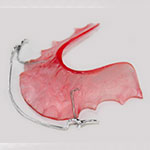Types of Appliances

Elastics
Wearing elastics (or rubber bands) improves the fit of your upper and lower teeth. Wear rubber bands as instructed, and remember that the rubber bands work far more efficiently if they're worn as prescribed.

Separators
Separators are little rubber doughnuts that may be placed between your teeth to push them apart so that orthodontic bands may be placed during your next appointment. The separators will be removed before we place the bands. Separators do not mix well with sticky foods, toothpicks, or floss.

Palate Expander
Palate expanders help your top jaw grow wider so the top back teeth
overlap the bottom back teeth. This also creates more room for permanent teeth to
erupt. When activated, the expander puts gentle pressure on your top molars. Once the desired growth is achieved, the expander maintains the jaw while the bone matures to prevent relapse.


Headgear
Headgear are used to improve the growth of the jaws in children. One type of headgear is used to slow the growth of the top jaw when the top teeth are too far forward of the bottom teeth (excessive overjet). Another type of headgear is used to encourage to top jaw to grow forward when the child has an underbite (the bottom teeth forward of the top teeth. Headgear is worn while a child is sleeping, not during the day or at school.

.jpg)

Retainers
Retainers may be clear or pink acrylic with wires. Once your treatment is complete, the retainers are worn to hold your teeth in their new position while the bones and ligaments mature. Retainers are worn full time for the first six months- taking them out to eat, brush and floss, or when wearing a mouthguard. After the first six months and your teeth are stable, you will wear retainers while sleeping at night. Retainers are worn on a regular basis for many years to protect the teeth from shifting with time.

Forsus™
The FORSUS is used in growing children to encourage growth of the bottom jaw and improve the bite.
Carriere Correction Appliance
What is the Carriere Appliance?
Used at the beginning of treatment, the Carriere Appliance corrects Class II malocclusion into a Class I occlusion. The Carriere can simplify treatment and reduce patient time in braces or aligners. It provides an alternative way to address malocclusions before braces are commenced. This appliance is one of the best non-surgical approaches for treating Class II occlusions.
The appliance is bonded to the upper first molar and the cuspid or bicuspid. Then, a molar tube is bonded to the lower first or second molar. Elastics connect to the molar tube up to the Carriere appliance. Patients will wear a clear retainer on the lower teeth, which provides anchorage. Patients can expect to wear the appliance 3-6 months, with office appointments every 6-8 weeks to monitor improvement. Not only does the bite improve, but also facial aesthetics, airway, and TMJ issues. Starting elastic treatment before braces fosters patient compliance at the start of treatment, when patient motivation is high. The patient may experience minor soreness on the molars and cuspids as the teeth begin their movement.
If you believe you or your child would benefit from a Carriere appliance, please request an appointment. You can learn more about common orthodontic issues here.
Already have a Carriere appliance? Here are the care instructions.






 Website Powered by Sesame 24-7™
Website Powered by Sesame 24-7™